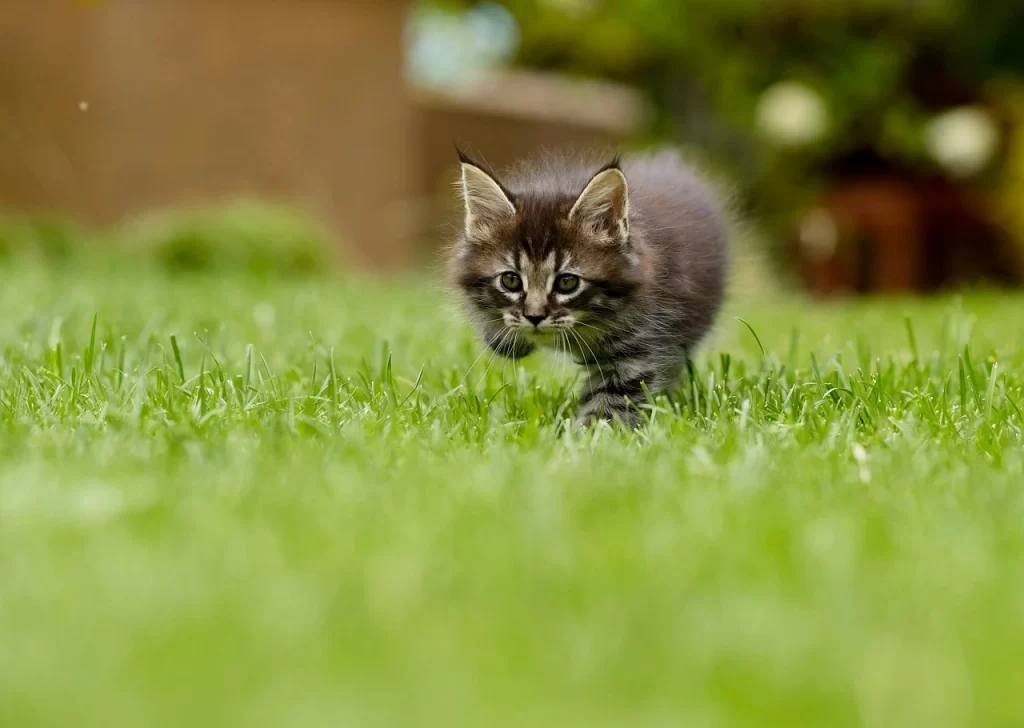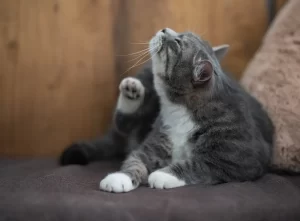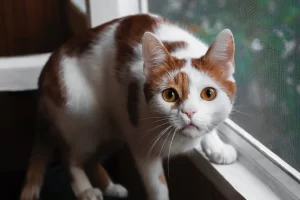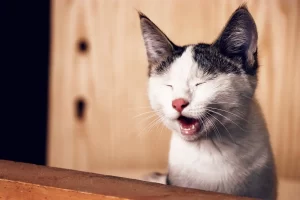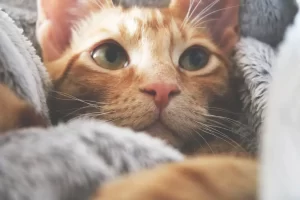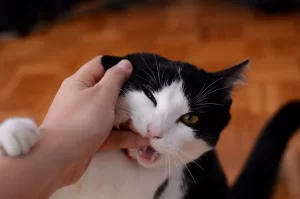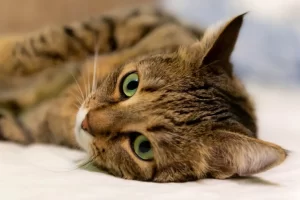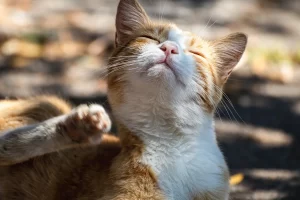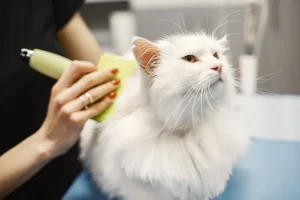Kitten prolapse is a serious condition that occurs when a portion of the kitten’s internal organs, such as the bladder, rectum, or uterus, protrude through the anus. While it can be a painful and alarming experience for both the kitten and its owner, prompt veterinary attention can prevent serious complications and ensure a successful recovery. This article will provide a comprehensive overview of kitten prolapse, including its definition, causes, and identification of mild versus severe cases. It will also cover important home treatment options, such as hygiene and wound care, diet, topical ointments, exercise, pain management, and prevention of future prolapses. Additionally, the cost associated with treatment and which type of veterinarian to seek out will be discussed. Whether you are a new kitten owner or an experienced cat parent, it’s important to familiarize yourself with kitten prolapse so that you can take appropriate action if your kitten is ever affected by this condition.
Table of Contents
ToggleCauses of Kitten prolapse
Kitten prolapse can cause significant discomfort and distress to the affected animal and requires prompt veterinary attention. There are several potential causes of kitten prolapse, including:
- Trauma: Physical injury or rough handling can result in prolapse.
- Straining during defecation: Excessive straining during bowel movements can cause the rectum to protrude.
- Obesity: Overweight or obese cats are more prone to developing prolapse due to the increased pressure placed on their internal organs.
- Congenital defects: Some kittens may be born with structural abnormalities that increase their risk of prolapse.
It’s important to be aware of the signs of prolapse in kittens and seek veterinary care promptly to prevent any further complications and promote healing.
Prolapse in kittens vs adult cats
Kitten prolapse is a medical condition that can occur in cats of any age, but it is more commonly seen in kittens. This is due to several factors, including the anatomy and lack of muscular development in younger cats, which can make them more susceptible to prolapse.
In addition to age, certain breeds of cats may be predisposed to prolapse due to genetic factors. For example, some short-faced breeds like Persians and Himalayans may have a higher risk of developing this condition due to their anatomy.
It’s important to note that while kitten prolapse is more common in younger cats and certain breeds, it can still occur in any cat.
Home treatment options for kitten prolapse
Here are the main home treatment options for mild cases of kitten prolapse:
- Confinement: Confine the kitten in a small, quiet area to reduce stress and prevent further injury.
- Cleaning: Clean the prolapsed tissue gently and regularly with a warm, damp cloth to prevent infection.
- Hydration: Ensure the kitten has access to fresh water to prevent dehydration and constipation.
- Soft Diet: Offer a soft, moist diet to help prevent straining during bowel movements.
- Gentle Exercise: Encourage gentle activity to promote blood flow and reduce swelling.
- Cool Compresses: Apply cool compresses to the prolapsed tissue to reduce swelling.
- Topical Ointments: Use a veterinary-approved topical ointment to soothe the affected area and promote healing.
- Pain Management: Provide pain management as directed by a veterinarian to ensure the kitten’s comfort.
- Proper Litter Box: Provide a clean, accessible litter box with low sides to make elimination easier.
- Avoidance of Constipation: Encourage regular elimination to avoid constipation and prevent further strain on the affected area.
- Prevention of Further Trauma: Protect the affected area from further trauma and injury.
- Monitoring for Complications: Observe the kitten closely and monitor for any signs of worsening or new symptoms.
- Follow-Up Veterinary Exams: Schedule regular follow-up veterinary exams to monitor the kitten’s progress and ensure that the treatment plan is effective.
- Maintenance of Good Hygiene: Maintain good hygiene practices to prevent the spread of infection.
- Support: Provide emotional support to the kitten and reduce stress as much as possible.
Home treatment options should only be used for mild cases and under the guidance of a veterinarian. In more severe cases, or if the prolapse worsens, seek emergency veterinary attention.
Herbal remedies for kitten prolapse
- Witch Hazel: This herb is used for its astringent properties, which may help reduce swelling and inflammation.
- Aloe Vera: This herb is known for its anti-inflammatory and soothing properties, which may help reduce pain and promote healing.
- Calendula: This herb is used for its anti-inflammatory and wound-healing properties, and may be applied topically as a cream or ointment.
- Arnica: This herb is used for its anti-inflammatory and pain-relieving properties, and may be applied topically as a cream or ointment.
Here are some general instructions for using herbal remedies for kitten prolapse:
- Witch Hazel: Dilute witch hazel extract with water and apply it to the affected area using a clean cloth. Repeat 2-3 times a day as needed.
- Aloe Vera: Apply aloe vera gel directly to the affected area 2-3 times a day.
- Calendula: Apply calendula cream or ointment to the affected area 2-3 times a day.
- Arnica: Apply arnica cream or ointment to the affected area 2-3 times a day.
When to seek emergency veterinary attention for kitten prolapse
Seek emergency veterinary attention for kitten prolapse if the following symptoms or changes occur:
- Worsening of prolapse: If the prolapse becomes larger, more painful, or changes in appearance, seek veterinary attention immediately.
- Inability to manually reduce the prolapse: If the prolapsed tissue cannot be manually reduced, this may indicate a severe case and require emergency veterinary attention.
- Signs of infection: If the affected area becomes swollen (read more about home remedies for swollen anus in cats here), hot, or painful, or if there is discharge or a foul odor, this may indicate an infection and require immediate veterinary attention.
- Difficulty or inability to defecate: If the kitten is unable or has difficulty defecating, this can lead to further complications and require emergency veterinary attention.
- Signs of distress or pain: If the kitten shows signs of severe discomforts, such as vocalizing, lethargy, or loss of appetite, this may indicate a more serious case and require emergency veterinary attention.
In conclusion, if there are any changes or worsening of symptoms, seek emergency veterinary attention promptly to prevent further complications and ensure the best outcome for the kitten.
Related article: How often do you take a cat to the vet?
Hygiene and wound care for kitten prolapse
Hygiene and wound care are important in the management of kitten prolapse. Proper hygiene and wound care can help prevent infection and promote healing. Here are some methods and instructions for hygiene and wound care for kitten prolapse:
- Cleaning: Clean the affected area gently and regularly with a warm, damp cloth. Use a gentle, non-irritating cleanser if recommended by your veterinarian.
- Drying: Pat the affected area dry after cleaning and avoid using hair dryers.
- Topical Ointments: Apply a veterinary-approved topical ointment to the affected area as directed by your veterinarian. This can help soothe the tissue and promote healing.
- Avoid Exposure: Keep the affected area covered and avoid exposing it to urine or feces.
- Litter Box Hygiene: Clean the kitten’s litter box regularly and avoid using harsh cleaners that can irritate the affected area.
- Hand Hygiene: Wash your hands thoroughly before and after handling the affected area to prevent the spread of infection.
- Avoid Touching: Avoid touching the affected area as much as possible to prevent further irritation or trauma.
- Monitoring: Observe the affected area closely and monitor for any signs of worsening or new symptoms. If you notice any changes, seek veterinary attention promptly.
You may also want to check out natural antibiotics that can be used for cat wounds.
Diet, nutrition, and supplement recommendations for kitten prolapse
Diet and nutrition play an important role in the management of kitten prolapse and overall health. A balanced and nutrient-rich diet can help promote healing and prevent complications. Here are some recommendations for diet and nutrition:
Diet:
- Feed the kitten a balanced and high-quality diet that is appropriate for their age, size, and activity level. Wet food may be easier to digest and can help prevent dehydration.
- Hydration: Ensure that the kitten is drinking enough water to maintain proper hydration. Offer water in a clean bowl or bottle and monitor the kitten’s water intake.
- Avoid Irritants: Avoid feeding the kitten foods or treats that can irritate the digestive system, such as spicy or fatty foods.
- Small, Frequent Meals: Offer small, frequent meals instead of large meals to help prevent straining during defecation.
Nutritional supplements may also be recommended to support the healing process and prevent complications. Here are some recommendations for nutritional supplements:
- Probiotics: Probiotics can help support digestive health and promote healing. Offer a veterinary-approved probiotic supplement as directed by your veterinarian.
- Omega-3 Fatty Acids: Omega-3 fatty acids can help reduce inflammation and promote healing. Offer a veterinary-approved omega-3 fatty acid supplement as directed by your veterinarian.
- Vitamins and Minerals: Vitamins and minerals can help support overall health and prevent deficiencies. Offer a veterinary-approved vitamin and mineral supplement as directed by your veterinarian.
It’s important to follow the instructions of your veterinarian and seek veterinary attention if there are any changes or worsening of symptoms. A balanced and nutrient-rich diet, along with appropriate nutritional supplements, can help promote healing and prevent complications for kitten prolapse.
Topical ointments and creams for kitten prolapse
Topical ointments and creams can be useful in the management of kitten prolapse to soothe the affected area and promote healing. Here are some recommendations for the use of topical ointments and creams:
- Selection: Use a veterinary-approved topical ointment or cream as directed by your veterinarian. Avoid using over-the-counter products without a veterinary recommendation.
- Application: Apply a thin layer of topical ointment or cream to the affected area as directed by your veterinarian. Avoid applying too much, as this can irritate the affected area.
- Frequency: Apply the topical ointment or cream as directed by your veterinarian. This may be done several times a day or as needed.
- Monitoring: Observe the affected area closely after application and monitor for any signs of skin irritation or worsening of symptoms. If you notice any changes, discontinue use and seek veterinary attention promptly.
Topical ointments and creams can be an effective part of the management of kitten prolapse when used as directed by a veterinarian. Here is a list of common topical ointments and creams used or recommended by veterinarians for the management of kitten prolapse:
- Silver sulfadiazine cream
- Chlorhexidine gluconate
- Hydrocortisone cream
- Polysporin
- Neosporin
- Betadine solution
Gentle exercise and confinement guidelines to manage kitten prolapse
Gentle exercise and confinement can play an important role in the management of kitten prolapse. Here are some guidelines for gentle exercise and confinement:
- Gentle Exercise: Encourage gentle exercise to promote circulation and prevent stagnation, such as supervised playtime and light grooming. Avoid rough play or activities that can put pressure on the affected area.
- Confinement: Confine the kitten in a safe and comfortable area that is easy to clean, such as a crate or a small room. Avoid exposing the kitten to harsh environments or stressful situations that can worsen symptoms.
- Monitoring: Observe the kitten closely and monitor for any signs of distress or worsening of symptoms. If you notice any changes, discontinue exercise and confinement and seek veterinary attention promptly.
Here are some examples of gentle exercise and confinement for a kitten with prolapse:
Gentle Exercise:
- Supervised playtime with soft toys
- Light grooming sessions
- Walking on a leash in a secure area
- Controlled jumping exercises
- Confinement:
- A clean, comfortable crate
- A small room with a soft bed and litter box
- A playpen with soft toys and a bed
Avoid constipation in kittens with prolapse
Constipation can worsen symptoms and slow down the healing process for kittens with prolapse. Here are some recommendations for avoiding constipation:
- Adequate hydration: Ensure that the kitten has access to fresh water and encourage drinking by offering a water fountain or wet food.
- Fiber-rich diet: Provide a diet that is high in fiber, such as canned food or add a fiber supplement to the diet, to promote regular bowel movements.
- Regular exercise: Encourage regular exercise to help promote bowel movements, such as supervised playtime and gentle grooming.
- Laxatives: Consult with a veterinarian to determine if a laxative may be necessary to manage constipation.
It’s important to monitor the kitten closely for any signs of constipation and seek veterinary attention promptly if constipation persists or worsens.
Treatment of underlying conditions in kittens with prolapse
Treating any underlying conditions is an important part of managing kitten prolapse. Some common underlying conditions that can contribute to prolapse include:
- Intestinal parasites: A parasite infestation can cause digestive issues and contribute to prolapse.
- Infections: Bacterial or viral infections can cause inflammation and weaken the tissue, leading to prolapse.
- Hormonal imbalances: Hormonal imbalances, such as hypothyroidism, can weaken the muscles and tissue, leading to prolapse.
- Congenital defects: Congenital defects, such as weakened muscles or malformed organs, can increase the risk of prolapse.
To treat underlying conditions, it’s important to seek veterinary attention and follow the recommended treatment plan. This may include medication, changes to diet and exercise, or surgery.
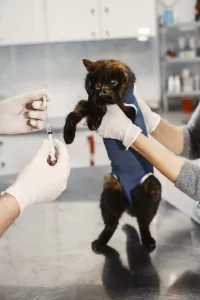
Medical treatments and Medicines for kittens with prolapse
Traditional medical treatments for kitten prolapse can include medications to manage pain, inflammation, and any underlying conditions. It’s important to consult with a veterinarian for the most appropriate treatment plan for each individual case, as the recommended treatments can vary based on the severity of the prolapse and any underlying conditions. Here are some common traditional medical treatments for kitten prolapse:
- Pain relief: Over-the-counter pain relief medications, such as acetaminophen or ibuprofen, may be recommended for mild to moderate pain.
- Anti-inflammatory: Nonsteroidal anti-inflammatory drugs (NSAIDs), such as meloxicam, may be prescribed to reduce inflammation and swelling.
- Antibiotics: Antibiotics may be prescribed to treat or prevent bacterial infections.
- Hormonal therapy: Hormonal therapy, such as thyroid replacement therapy, may be necessary to manage hormonal imbalances that contribute to prolapse.
- Surgery: In severe cases, surgery may be necessary to repair the prolapse and prevent further complications.
Prevention of future prolapses
Preventing future prolapses is an important part of managing kitten prolapse. Here are some recommendations for preventing future prolapses:
- Maintaining a healthy weight: Overweight and obese kittens are more prone to developing prolapses, so maintaining a healthy weight is important.
- Regular exercise: Encouraging regular exercise, such as supervised playtime, can help strengthen the muscles and prevent prolapses.
- Proper nutrition: Providing a balanced and nutritious diet, including adequate fiber and hydration, can prevent constipation and reduce the risk of prolapses.
- Regular veterinary check-ups: Regular veterinary check-ups can help detect and treat any underlying conditions, such as hormonal imbalances or infections, that contribute to prolapses.
- Avoiding rough play: Avoid rough play and handling that can cause injury or strain to the muscles and tissues.
- Addressing congenital defects: If the kitten has a congenital defect that increases the risk of prolapses, such as weakened muscles or malformed organs, addressing this issue with veterinary care can help prevent future prolapses.
By following these recommendations and seeking veterinary attention promptly if symptoms worsen or persist, it is possible to prevent future prolapses and promote healing for kittens with prolapses.
Pain management in kittens with prolapse
Pain management is an important aspect of caring for kittens with prolapse. Pain can cause discomfort and stress, and can make it difficult for the kitten to rest and heal. Here are some recommendations for managing pain in kittens with prolapse:
- Over-the-counter pain relief: Over-the-counter pain relief medications, such as acetaminophen or ibuprofen, may be recommended for mild to moderate pain.
- Anti-inflammatory medication: Nonsteroidal anti-inflammatory drugs (NSAIDs), such as meloxicam, may be prescribed to reduce inflammation and swelling, which can also help to manage pain.
- Warm compresses: Warm compresses, such as a warm cloth or heating pad, can help to relieve pain and promote circulation.
- Gentle exercise: Gentle exercise, such as supervised playtime, can help to promote circulation and reduce pain and stiffness.
- Confinement: Confining the kitten to a small, quiet area can help to reduce stress and promote rest and healing.
- Alternative therapies: Some alternative therapies, such as acupuncture or massage, may help to relieve pain and promote healing.
- Prescription pain medications: In some cases, prescription pain medications may be needed for more severe pain. These may include opioids, such as fentanyl or morphine, or local anesthetics, such as bupivacaine.
- Surgical intervention: If the prolapse cannot be corrected through non-surgical methods, surgical intervention may be necessary. This can help to relieve pain and restore normal function.
- Cold compresses: Cold compresses, such as an ice pack, may be used to reduce swelling and numb the area, which can help to relieve pain.
Would kitten prolapse go away on its own?
In some cases, a mild kitten prolapse may resolve on its own, particularly if the kitten is otherwise healthy and not experiencing significant pain or discomfort. However, this is not a guaranteed outcome, and prompt veterinary attention is still recommended.
In most cases, prompt veterinary attention is required to properly diagnose the prolapse and to determine the best course of treatment. This may involve medical treatment, such as topical ointments and creams, as well as confinement, hygiene, and wound care. In some cases, surgical intervention may be necessary to correct the prolapse.
Possible complications if kitten prolapse is left untreated
If a kitten prolapse is left untreated, it can lead to a number of serious complications, including:
- Infection: A prolapsed tissue is exposed and susceptible to bacterial infection, which can worsen the prolapse and cause tissue death.
- Tissue death: If the prolapsed tissue becomes deprived of blood flow, it may die, leading to tissue loss and permanent damage.
- Constipation: Chronic constipation can further strain the pelvic floor muscles and increase the risk of recurrent prolapses.
- Chronic pain and discomfort: Without proper treatment, a kitten with prolapse may experience ongoing pain and discomfort, which can impact their quality of life.
- Fecal incontinence: Chronic straining and constipation can weaken the pelvic floor muscles and lead to fecal incontinence.
- Long-term dysfunction: In severe cases, untreated prolapses can lead to long-term pelvic floor dysfunction, which may require ongoing medical treatment and management.
For these reasons, it’s important to seek prompt veterinary care for kittens with prolapses, even if they appear mild.
How long would kitten prolapse take to heal?
The length of time it takes for a kitten prolapse to heal will depend on several factors, including the severity of the prolapse, the underlying cause, and the course of treatment.
In mild cases, the prolapse may resolve on its own within a few days with proper confinement, hygiene, and wound care. In more severe cases, surgical intervention may be necessary to correct the prolapse, which can take several weeks or more to heal, depending on the extent of the surgery and the kitten’s overall health.
After surgery, the kitten may need to be confined and undergo a period of strict rest, along with topical ointments and creams, to promote healing and prevent recurrent prolapses. In some cases, dietary changes and supplements may also be recommended to support recovery and prevent future prolapses.
Can you push the organs back in kittens with prolapse?
Treatment costs for kitten prolapse
The cost of treating a kitten prolapse can vary widely and is difficult to estimate without a thorough examination by a veterinarian. However, some rough estimates of the costs associated with different steps of treatment are as follows:
- Initial veterinary exam: $50 to $200
- Medications: $10 to $100
- Home care supplies: $50 to $100
- Surgical intervention: $500 to $2,000 or more
- Follow-up exams: $50 to $100 per visit
These estimates are rough and can vary greatly depending on a number of factors, such as where you live, the severity of the prolapse, and the underlying cause. Additionally, the cost of treating any underlying conditions that may have contributed to the prolapse will also need to be taken into consideration.
Finding the right veterinarian for your kitten’s prolapse
If your kitten has a prolapse, it’s important to seek veterinary care as soon as possible. The type of veterinarian you should see will depend on the severity of the prolapse and any underlying conditions that may be contributing to it.
- General Practitioner (GP) Veterinarian: For mild cases of kitten prolapse, a general practitioner veterinarian may be able to provide adequate care, including initial evaluation, wound care, and pain management.
- Board-Certified Surgeon: If surgery is necessary, it’s best to see a board-certified veterinary surgeon. These veterinarians have received specialized training in surgical procedures and have the expertise to provide the best possible care for your kitten.
- Board-Certified Internal Medicine Specialist: If the kitten has an underlying medical condition, such as a congenital abnormality or infection, it may be best to see a board-certified internal medicine specialist. These veterinarians have specialized training in diagnosing and treating internal medical conditions.
It’s important to choose a veterinarian who you trust and who has experience treating kittens with prolapses.

